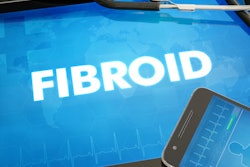
For women with symptomatic uterine fibroids, uterine artery embolization (UAE) improves symptoms and total health-related quality of life more than MR-guided high-intensity focused ultrasound (MR-HIFU), Berlin researchers have reported in an article published this month in the European Journal of Radiology (3 September 2013).
Women with symptomatic uterine fibroids have several options for treatment, especially if they seek minimally invasive uterus-sparing alternatives. UAE has emerged as the leading minimally invasive treatment for fibroids since a seminal publication by Ravina and colleagues was published in 1995 (Lancet, 9 September 1995, Vol. 346:8976, pp. 671-672).
However, in 2004, the U.S. Food and Drug Administration (FDA) approved MR-guided high-intensity focused ultrasound for fibroid treatment, leading to growing interest in this technique.
Both UAE and MR-HIFU have been recognized as safe and effective treatments for symptomatic fibroid disease, although no direct comparison of the two has been published until now, according to Dr. Vera Froeling, from the radiology department at Charité - University Medicine in Berlin, and colleagues.
Froeling and colleagues evaluated and compared the long-term reintervention rate and changes in symptom severity, as well as total health-related quality of life scores, among 77 patients undergoing UAE or MR-HIFU for symptomatic uterine fibroids. They used a questionnaire with a five-point Likert scale that assessed fibroid symptom severity using a zero-point scale and quality of life using a 100-point scale for the comparison. A lower symptom severity score indicates the treatment was effective. The opposite is true for the quality of life score -- the higher the better.
Patients' scores were recorded before treatment and a median of 61.9 months after UAE, as well as a median of 60.7 months after MR-HIFU. Reintervention rates were assessed for each therapy and compared.
Reintervention was significantly lower after UAE than after MR-guided HIFU at long-term follow-up, the researchers found. The reintervention rates and the changes in symptom severity and total health-related quality of life scores before and after both treatments are shown below.
| Patient scores for UAE versus MR-HIFU | |||||
| Before UAE | After UAE | Before MR-HIFU | After MR-HIFU | ||
| Symptom severity | 50 | 6.3 | 42.2 | 26.6 | |
| Quality of life | 57.8 | 100 | 66.4 | 87.9 | |
| Reintervention rate | 12.2% | 66.7% | |||
UAE and MR-HIFU can significantly change symptom severity and total health-related quality of life for women with symptomatic fibroids, Froeling and colleagues concluded. "When both treatments are compared, UAE results in a significantly lower reintervention rate and a significantly better health-related quality of life improvement than [MR-HIFU] at long-term follow-up," they wrote.
A possible limitation of the study is that the women who underwent UAE had a significantly higher total fibroid tissue volume at baseline, which reflects a greater extent of disease and could also have biased the study's results in favor of MR-HIFU, the authors acknowledged.
Another limitation was the restrictive MR-HIFU treatment protocol. One of the included women was treated by the original protocol covered in an FDA approval of the technology in 2004, but all others were treated using a more aggressive modified treatment protocol after that year, which resulted in a more extensive thermoablation of fibroid volume.
According to the FDA approval from 2004, a second intervention within two weeks is defined as one therapy. Due to logistical reasons, a repeat MR-HIFU treatment within this range was not possible at the researchers' institution, so second treatment within 12 weeks after the first therapy was defined as one treatment.
"It is noteworthy that many women who underwent [MR-HIFU] became pregnant (25%), whereas one woman became pregnant twice," they wrote.
Also, 70% of the women who became pregnant after MR-HIFU successfully carried their pregnancies to term.
"Considering these data, [MR-HIFU] seems to be a more appropriate treatment for women with future childbearing plans being a noninvasive treatment without x-ray use," they wrote. "This potential bridging function of [MR-HIFU] for women with future childbearing plans should be investigated further."
Women who search for a permanent and definitive symptom release treatment from fibroids would do well to choose UAE, the researchers concluded. However, for women who are aware of the possible treatment failure of MR-HIFU -- and the consecutive need of a second intervention -- and would like to bear children, MR-HIFU is more suitable, they noted.



















